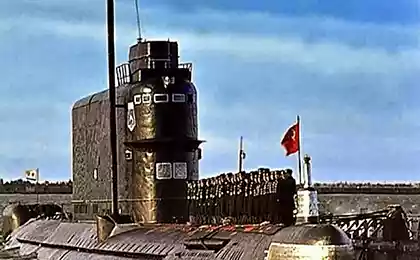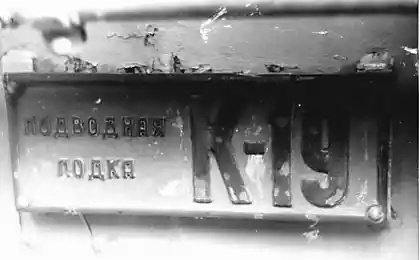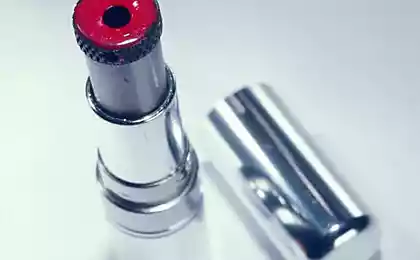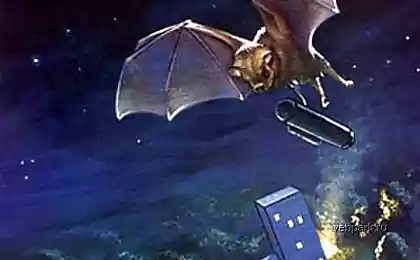1160
As CIA Soviet submarine raised
Declassified documents reveal new details of US intelligence mission to raise a sunken Soviet submarine
Historical support the United States in a series of "International Relations of the United States" has published a volume devoted to national security policy in the years 1973-1976. Publication io9 found among nearly a thousand pages of transcripts of meetings and internal documents of the Office 200 dedicated to the project "Azorian" - partly succeeding CIA attempt to raise from the seabed Soviet submarine K-129.
The submarine K-129, 1965

The submarine K-129 was launched in 1959. It was built under the project 629 - diesel-electric submarines carrying ballistic missiles, three P-13. Total of 24 pieces were produced. K-129 later converted project 629A - for R-21.
March 8, 1968 K-129 sank in the North Pacific Ocean, about three thousand kilometers from the Hawaiian Islands, at 5, 6 thousand meters. On board were 98 people. Officially, the submarine flooded with water through faulty valve inlet. Americans hold versions of false positives rocket motors in closed mines - this indicates a high background radiation in the lessons, and the ruins of the noise, for which a submarine sonar operators find the system SOSUS.
USSR was looking for K-129 two months, but never found. Exploration US Navy realized what had happened, by the activity of the Soviet fleet in the region of the famous Route project 629 submarines and forced operators SOSUS listen to hours and days of archival records in search of something similar to an explosion. This will narrow the search to three thousand square kilometers. From Pearl Harbor to the submarine went USSHalibut, equipped with deep-search engines. K-129 was found three weeks - in August 1968.
Washington decided that Soviet submarine with ballistic missiles on board - it's just a gift from heaven. If it managed to raise, at the disposal of the Pentagon would have the technology of R-21, cryptographic equipment and documentation. It remains to understand how to get the submarine mass 2, 5 thousand tons from a depth of 5, 5 km, and even so that no one noticed. So there was a secret CIA project "Azorian».
In another part of the "Bond", released in 1977, featured a giant tanker exciting nuclear submarines. Perhaps inspired screenwriter published two years before the leaks concerning the project "Azorian." To get the K-129 from the bottom of the Pacific Ocean, the CIA decided to create a giant ship in the bottom of which is hidden hoist and dock for submarines. He also had to be equipped with a stabilization systems, such as whether used on drilling platforms.
The capture device designed specifically for the Soviet submarine, is collected separately in a closed barge. To install it on a ready-made vessel, a barge had to flood and complete installation of the water - as the appointment of the ship could be hidden from most employees.
Construction was entrusted to the company GlobalMarineDevelopment, used SunShipbuilding Shipyard in Philadelphia. The ship was named "Hughes Glomar Explorer" - according to legend, the ship building industrial tycoon Howard Hughes, to produce iron-manganese nodules from the seabed. The billionaire did not object to the use of his name, his company, and so fulfill the set of secret military contracts.
"Mr. Hughes - a recognized pioneer entrepreneur with a wide range of business interests; he has the necessary financial resources; He often acts in secret; and he is so eccentric that media reports about his activities often vary from the truth committed to fables "- explains the choice of project managers legend Secretary of State Henry Kissinger in a letter dated May 1974. It was among the documents included in the present publication of the State Department.
Development, construction and testing of the project lasted until 1974 - and even then, ended in a hurry. Six years after the death of K-129 in Washington have doubted whether the game was worth the candle: the Soviet Union switched to R-29, a much greater range. The usefulness of the information that would be able to get disassembled P-21 was called into question.
Then-CIA director William Colby, however, insisted on the continuation of the mission, not wanting to spoil relations with salaried personnel. "We need to take care of the reputation of the state. Closing of the project on such a late stage seem contractors tyranny. This is important for intelligence programs, which cover safety issues and require a closer relationship between the contractor and the state, "- he explained in another letter published by the State Department.
As a result, July 4, 1974, "Hughes Glomar Explorer" arrived at the death of K-129. The operation to lift the submarine lasted more than a month: it was necessary to wait for the perfect weather. In addition, the incredible size of the craft of unknown purpose twice drew the attention of Soviet ships in the area.
By early August, "Clementine," as the sailors called the capture device, go to the bottom step on the tube, such as a drill. It was supposed to raise more than half of the submarine at a time - the front 42 meters. However, two-thirds of the captured, including the wheelhouse collapsed back - steel "claws" could not stand the load. As a result, in a hidden dock "Glomar Explorer" were only the first 11 meters of the bow of the K-129.
The operation was declared partly successful: according to official information, in an elevated fragment of the submarine were two torpedoes with nuclear warheads and six crew members. Some staff project azorian later claimed that it was possible to "save" codebooks and other documentation.
Soviet sailors buried at sea with military honors. Because of the high background radiation body lowered in metal coffins. According to the State Department published the correspondence, initially considered the possibility to save personal belongings of the deceased for onward transmission to the native: it might ease the tension, if the Soviet Union had learned about the project.
Intelligence agents filmed the entire operation to lift the boats on film for the archive department. In 1992, CIA Director Robert Gates gave a fragment of recording the burial ceremony Russian President Boris Yeltsin.
Fragments of "Clementine" and K-129 had not yet touched bottom, and the CIA is already preparing for a second attempt. It was clear that "the Hughes Glomar Explorer" will return to the dock and significantly revise the system of capture. So the new sailing ship "dual use" would be held until next favorable weather of the season - the second half of the summer of 1975.

Ship Hughes Glomar Explorer. Photo: AP
The failure of the "Azorianom", however, came in the midst of the Watergate scandal. August 9, 1974, US President Richard Nixon had resigned under threat of impeachment, so for many people in Washington were not the priority of ambitious projects with dubious international consequences, and "cover rears».
Even Henry Kissinger has always supported the operation "Azorian" began to consider it a time bomb. "This story will inevitably seep: too many have to devote to the cause. All remaining guts. Yesterday, they kept trying to make it clear that they want to protect themselves from "Azoriana." Depressing meeting, "- he explained his position to the new President Gerald Ford in the published transcript of the State Department.
The fact that the project "Azorian" is about to become public knowledge, it is best understood within the CIA. In January 1974 their draft NewYorkTimes learned journalist Seymour Hersh. Director William Colby Minister met twice with him, coaxing to postpone the publication of the investigation because of the threat of an international scandal.
The second meeting of Hersh and Colby held February 10, 1975. But three days earlier about the real purpose of "Hughes Glomar Explorer" wrote LosAngelesTimes. The newspaper learned about the secret project through its own oversight of the CIA.
June 5, 1974 the office of one of the companies working on the "Glomar Explorer", was robbed. In addition to money, the criminals have taken out four boxes of documents. Among them could be a memo describing the project "Azorian" - if it is, as expected, did not destroy after reading.
A few months later, the LAPD asked the man, who identified himself as a mediator, in whose hands were documents. Last demanded of them $ 500 million. The CIA tried to find out if any of the securities description "Azoriana", and told the FBI about the note. Those handed police and the latter asked the mediator.
So this story and came to Los Angeles Times. Their first note was short, with a lot of inaccuracies and questionable sources, so that the CIA continued to insist on silence journalists who knew the details of the case. But the March 18, 1975 of its intention to disclose all the details publicly stated columnist Jack Anderson. This untied the hands of others: New York Times, Washington Post and Los Angeles Times came out with editorials of the "Glomar Explorer».
Hersh and colleagues mistakenly called secret project "Jennifer" - is the code name used for all the documents to indicate the category of secrecy. The CIA and the US Defense Department on general levels of tolerance has priority system information blocks: classified documents and objects are divided into conventional "cell", the right of access in each of which is determined by the additional criteria - the need for a service, guarantees and so on.
Ford administration decided to ignore the publication in the press. The temptation to accept the existence of an ambitious project, of course, was great. "This episode - an important achievement of America. This operation - technological wonder with secrecy, "- said the Minister of Defense James Schlesinger, at the meeting of the president with the power unit March 19, 1975 (transcript declassified in 2010).
Further publicity, however, could force the Soviet Union to take retaliatory action, so the project "Azorian" remained classified. On formal requests under the Freedom of Information Act (FOIA) The CIA responded wording "we can neither confirm nor deny." This phrase is now called "Glomar response" or "glomarizatsiey».
From the Soviet Union waited for a sharp reaction, as in the incident with the spy plane U-2 in 1960. Moscow is silent. According to the CIA, the Kremlin chose not to publicly recognize the loss of the submarine, the inability to find a place of her death and the failure of intelligence on the ship "Glomar Explorer».
In the same report from April 1975 CIA analysts warned: "There is no doubt that the Soviets would do everything possible to complicate or disrupt the second attempt." Couples divers armed with several meters of cable, enough to damage the device, such as "Clementine." And most importantly, in the Soviet Union is now know where lies the K-129.
As a result, the US government gave up trying to pick up the remains of Soviet submarines. In June 1975, Kissinger wrote Ford, "It is now clear that the Soviets did not intend to allow us to smoothly carry out a second mission. Soviet tug on duty at the goal from 28 March, and by all indications will remain there. Our system is vulnerable to capture the most innocent of events at sea, such as boats, passing too close and "accidentally" hurting the ship. The threat of more aggressive hostile reaction also present up to a direct confrontation with the Soviet Navy ships ».
Officially, this project «Azorian" and closed. "Glomar Explorer" is really converted to deep-sea drilling, and in 2010 sold to another company.
Now the project "Azorian" remains a secret. Most of the available reliable information became known only in 2010. Then were published transcript of the meeting, said Ford's security forces and subjected to censorship of art fair in 1985 from an internal journal of the CIA. There is still not clear exactly what the Americans were able to raise from the bottom, besides torpedoes and bodies of sailors, many of the details are hidden mission planning and preparation of the ship, including the appointment of several field laboratories placed on board at the last minute.
But it is known as the three US presidential administrations have spent on a secret project - $ 800 million. In terms of today's dollars is about $ 4 billion. "Azorian" has become one of the most expensive covert operations of the Cold War.
Historical support the United States in a series of "International Relations of the United States" has published a volume devoted to national security policy in the years 1973-1976. Publication io9 found among nearly a thousand pages of transcripts of meetings and internal documents of the Office 200 dedicated to the project "Azorian" - partly succeeding CIA attempt to raise from the seabed Soviet submarine K-129.
The submarine K-129, 1965

The submarine K-129 was launched in 1959. It was built under the project 629 - diesel-electric submarines carrying ballistic missiles, three P-13. Total of 24 pieces were produced. K-129 later converted project 629A - for R-21.
March 8, 1968 K-129 sank in the North Pacific Ocean, about three thousand kilometers from the Hawaiian Islands, at 5, 6 thousand meters. On board were 98 people. Officially, the submarine flooded with water through faulty valve inlet. Americans hold versions of false positives rocket motors in closed mines - this indicates a high background radiation in the lessons, and the ruins of the noise, for which a submarine sonar operators find the system SOSUS.
USSR was looking for K-129 two months, but never found. Exploration US Navy realized what had happened, by the activity of the Soviet fleet in the region of the famous Route project 629 submarines and forced operators SOSUS listen to hours and days of archival records in search of something similar to an explosion. This will narrow the search to three thousand square kilometers. From Pearl Harbor to the submarine went USSHalibut, equipped with deep-search engines. K-129 was found three weeks - in August 1968.
Washington decided that Soviet submarine with ballistic missiles on board - it's just a gift from heaven. If it managed to raise, at the disposal of the Pentagon would have the technology of R-21, cryptographic equipment and documentation. It remains to understand how to get the submarine mass 2, 5 thousand tons from a depth of 5, 5 km, and even so that no one noticed. So there was a secret CIA project "Azorian».
In another part of the "Bond", released in 1977, featured a giant tanker exciting nuclear submarines. Perhaps inspired screenwriter published two years before the leaks concerning the project "Azorian." To get the K-129 from the bottom of the Pacific Ocean, the CIA decided to create a giant ship in the bottom of which is hidden hoist and dock for submarines. He also had to be equipped with a stabilization systems, such as whether used on drilling platforms.
The capture device designed specifically for the Soviet submarine, is collected separately in a closed barge. To install it on a ready-made vessel, a barge had to flood and complete installation of the water - as the appointment of the ship could be hidden from most employees.
Construction was entrusted to the company GlobalMarineDevelopment, used SunShipbuilding Shipyard in Philadelphia. The ship was named "Hughes Glomar Explorer" - according to legend, the ship building industrial tycoon Howard Hughes, to produce iron-manganese nodules from the seabed. The billionaire did not object to the use of his name, his company, and so fulfill the set of secret military contracts.
"Mr. Hughes - a recognized pioneer entrepreneur with a wide range of business interests; he has the necessary financial resources; He often acts in secret; and he is so eccentric that media reports about his activities often vary from the truth committed to fables "- explains the choice of project managers legend Secretary of State Henry Kissinger in a letter dated May 1974. It was among the documents included in the present publication of the State Department.
Development, construction and testing of the project lasted until 1974 - and even then, ended in a hurry. Six years after the death of K-129 in Washington have doubted whether the game was worth the candle: the Soviet Union switched to R-29, a much greater range. The usefulness of the information that would be able to get disassembled P-21 was called into question.
Then-CIA director William Colby, however, insisted on the continuation of the mission, not wanting to spoil relations with salaried personnel. "We need to take care of the reputation of the state. Closing of the project on such a late stage seem contractors tyranny. This is important for intelligence programs, which cover safety issues and require a closer relationship between the contractor and the state, "- he explained in another letter published by the State Department.
As a result, July 4, 1974, "Hughes Glomar Explorer" arrived at the death of K-129. The operation to lift the submarine lasted more than a month: it was necessary to wait for the perfect weather. In addition, the incredible size of the craft of unknown purpose twice drew the attention of Soviet ships in the area.
By early August, "Clementine," as the sailors called the capture device, go to the bottom step on the tube, such as a drill. It was supposed to raise more than half of the submarine at a time - the front 42 meters. However, two-thirds of the captured, including the wheelhouse collapsed back - steel "claws" could not stand the load. As a result, in a hidden dock "Glomar Explorer" were only the first 11 meters of the bow of the K-129.
The operation was declared partly successful: according to official information, in an elevated fragment of the submarine were two torpedoes with nuclear warheads and six crew members. Some staff project azorian later claimed that it was possible to "save" codebooks and other documentation.
Soviet sailors buried at sea with military honors. Because of the high background radiation body lowered in metal coffins. According to the State Department published the correspondence, initially considered the possibility to save personal belongings of the deceased for onward transmission to the native: it might ease the tension, if the Soviet Union had learned about the project.
Intelligence agents filmed the entire operation to lift the boats on film for the archive department. In 1992, CIA Director Robert Gates gave a fragment of recording the burial ceremony Russian President Boris Yeltsin.
Fragments of "Clementine" and K-129 had not yet touched bottom, and the CIA is already preparing for a second attempt. It was clear that "the Hughes Glomar Explorer" will return to the dock and significantly revise the system of capture. So the new sailing ship "dual use" would be held until next favorable weather of the season - the second half of the summer of 1975.

Ship Hughes Glomar Explorer. Photo: AP
The failure of the "Azorianom", however, came in the midst of the Watergate scandal. August 9, 1974, US President Richard Nixon had resigned under threat of impeachment, so for many people in Washington were not the priority of ambitious projects with dubious international consequences, and "cover rears».
Even Henry Kissinger has always supported the operation "Azorian" began to consider it a time bomb. "This story will inevitably seep: too many have to devote to the cause. All remaining guts. Yesterday, they kept trying to make it clear that they want to protect themselves from "Azoriana." Depressing meeting, "- he explained his position to the new President Gerald Ford in the published transcript of the State Department.
The fact that the project "Azorian" is about to become public knowledge, it is best understood within the CIA. In January 1974 their draft NewYorkTimes learned journalist Seymour Hersh. Director William Colby Minister met twice with him, coaxing to postpone the publication of the investigation because of the threat of an international scandal.
The second meeting of Hersh and Colby held February 10, 1975. But three days earlier about the real purpose of "Hughes Glomar Explorer" wrote LosAngelesTimes. The newspaper learned about the secret project through its own oversight of the CIA.
June 5, 1974 the office of one of the companies working on the "Glomar Explorer", was robbed. In addition to money, the criminals have taken out four boxes of documents. Among them could be a memo describing the project "Azorian" - if it is, as expected, did not destroy after reading.
A few months later, the LAPD asked the man, who identified himself as a mediator, in whose hands were documents. Last demanded of them $ 500 million. The CIA tried to find out if any of the securities description "Azoriana", and told the FBI about the note. Those handed police and the latter asked the mediator.
So this story and came to Los Angeles Times. Their first note was short, with a lot of inaccuracies and questionable sources, so that the CIA continued to insist on silence journalists who knew the details of the case. But the March 18, 1975 of its intention to disclose all the details publicly stated columnist Jack Anderson. This untied the hands of others: New York Times, Washington Post and Los Angeles Times came out with editorials of the "Glomar Explorer».
Hersh and colleagues mistakenly called secret project "Jennifer" - is the code name used for all the documents to indicate the category of secrecy. The CIA and the US Defense Department on general levels of tolerance has priority system information blocks: classified documents and objects are divided into conventional "cell", the right of access in each of which is determined by the additional criteria - the need for a service, guarantees and so on.
Ford administration decided to ignore the publication in the press. The temptation to accept the existence of an ambitious project, of course, was great. "This episode - an important achievement of America. This operation - technological wonder with secrecy, "- said the Minister of Defense James Schlesinger, at the meeting of the president with the power unit March 19, 1975 (transcript declassified in 2010).
Further publicity, however, could force the Soviet Union to take retaliatory action, so the project "Azorian" remained classified. On formal requests under the Freedom of Information Act (FOIA) The CIA responded wording "we can neither confirm nor deny." This phrase is now called "Glomar response" or "glomarizatsiey».
From the Soviet Union waited for a sharp reaction, as in the incident with the spy plane U-2 in 1960. Moscow is silent. According to the CIA, the Kremlin chose not to publicly recognize the loss of the submarine, the inability to find a place of her death and the failure of intelligence on the ship "Glomar Explorer».
In the same report from April 1975 CIA analysts warned: "There is no doubt that the Soviets would do everything possible to complicate or disrupt the second attempt." Couples divers armed with several meters of cable, enough to damage the device, such as "Clementine." And most importantly, in the Soviet Union is now know where lies the K-129.
As a result, the US government gave up trying to pick up the remains of Soviet submarines. In June 1975, Kissinger wrote Ford, "It is now clear that the Soviets did not intend to allow us to smoothly carry out a second mission. Soviet tug on duty at the goal from 28 March, and by all indications will remain there. Our system is vulnerable to capture the most innocent of events at sea, such as boats, passing too close and "accidentally" hurting the ship. The threat of more aggressive hostile reaction also present up to a direct confrontation with the Soviet Navy ships ».
Officially, this project «Azorian" and closed. "Glomar Explorer" is really converted to deep-sea drilling, and in 2010 sold to another company.
Now the project "Azorian" remains a secret. Most of the available reliable information became known only in 2010. Then were published transcript of the meeting, said Ford's security forces and subjected to censorship of art fair in 1985 from an internal journal of the CIA. There is still not clear exactly what the Americans were able to raise from the bottom, besides torpedoes and bodies of sailors, many of the details are hidden mission planning and preparation of the ship, including the appointment of several field laboratories placed on board at the last minute.
But it is known as the three US presidential administrations have spent on a secret project - $ 800 million. In terms of today's dollars is about $ 4 billion. "Azorian" has become one of the most expensive covert operations of the Cold War.























